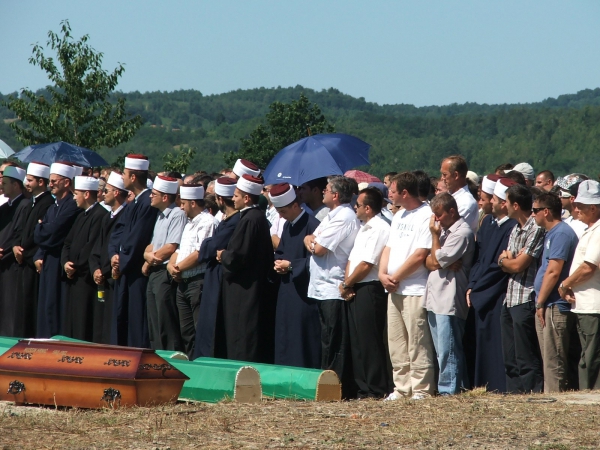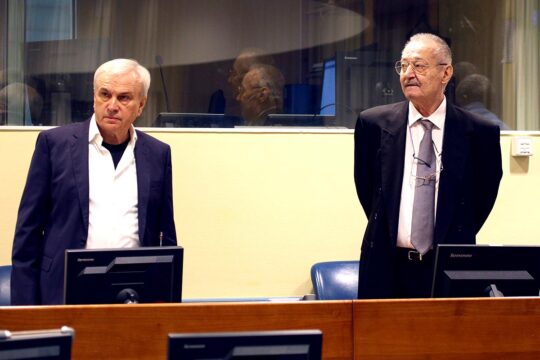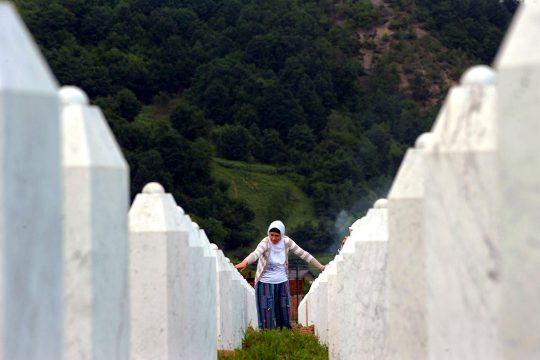Myriads of often-unspeakable traumas are generated by wars. Together with killings, rapes, plundering, and mutilations, the trauma of not knowing what happened to loved ones is a burning and everyday issue for thousands of people around the world. Bosnia and Herzegovina (BiH), the most multi-ethnic country in the former Yugoslavia, emerged from the 1991-1995 conflict in the region with the highest number of casualties, devastation, and also missing people. By the end of the war, approximately 31,500 people in Bosnia alone were unaccounted for. Given Bosnia’s catastrophic devastation, it soon became the primary playground for international transitional justice efforts. Alongside the first UN ad hoc international tribunal, the International Criminal Tribunal for the former Yugoslavia (ICTY), which was established in 1993, Bosnia’s fate also set in motion a global search for the missing through the creation of the International Commission for Missing Persons (ICMP) in 1996.
The scale of the atrocities committed in the 1991-1995 Yugoslav wars indeed mobilized human rights advocates and policy makers, engendering massive international involvement in the post-war reconstruction of the Balkans. The United Nations, NATO, OSCE, the European Union and global and regional charities have directed most of their attention to BiH, investing significant resources in its post-war recovery.According to the IMF, BiH alone has received more per capita in foreign aid than any European state after the Second World War. Only between 1996-1999, US $3.7 billion were sent to the country. Post-war justice was meant to come with the ICTY’s judgments and the evidence produced before it. However, the degree to which this has been achieved is so far disputed, especially in terms of its direct benefit for the survivors, as studies such as Meernik and Guerrero's from 2014 showed. Notwithstanding its debatable nature, the ICTY has spearheaded a new era of universal international criminal prosecution and the extensive evidence presented before it has at least reduced the number of “permissible lies”, to quote Michael Ignatieff.
With the ICTY gaining the transitional justice spotlight in the Balkans, the existence of the ICMP, through which the Balkans have been teaching a global lesson on how to deal with questions of truth and justice in post-war situations, is too often forgotten. Its track record so far is quite impressive. Out of the original number of missing, by 2014, the fate of “only” 8,500 people from Bosnia was still unknown. Over 75% of the missing have been identified – the highest percentage of all post-war countries (e.g. Iraq, Nepal, Sri Lanka, Columbia. In Columba, only around 3,000 people have been identified out of the nearly 70,000 missing persons).Unlike the ICTY, the ICMP was established in BiH with its headquarters in Sarajevo and offices in Tuzla, and Banja Luka (as well as Pristina in Kosovo). It is funded by donor governments (including most European countries, the US, and even the Holy See), the EU, and the C.S. Mott Foundation. Since 2003, when its mandate was extended beyond the Western Balkans, the ICMP– staffed by Bosnian citizens at a rate of 85% – has been functioning as the world’s hub for the search for missing persons. Its role in Bosnia has been irreplaceable since its establishment.
First, its technical and scientific expertise was fundamental for locating mass graves and identifying bodily remains under extremely difficult circumstances: during the conflict, bodies were dug out of primary graves and moved into secondary and tertiary sites, making identification a tortuous and expensive process. Initially, searches were carried out exclusively on the basis of information obtained from witnesses and families (as well as perpetrators), and the identification of bodily remains had to be made personally or through blood samples from family members. To simplify the identification procedures, the ICMP developed a new technology, which has since 2001 allowed for DNA-based computer-processed matching of body parts to family members. This required the creation of a DNA bank through the gathering of blood samples from relatives, including from members of what is now a very large diaspora. The Bosnian diaspora was mobilized across the world and the ICMP carried out several waves of blood samplings abroad. The technology eventually achieved a certainty of 99.9% accuracy rate for identifying a person, and has now been applied in other areas in the world, such as for the remains of the victims of the 9/11 in New York.
Second, the ICMP’s work has demonstrated that a seemingly technical process of forensic identification can have far-reaching healing properties. Resolving the fate of the missing is a crucial step towards restoring social relationships. Several academic works such as Stover and Shigekane’s from 2006 showed that finding bodies of family members helps bereaved families to deal with the war trauma by moving on and directing their grief at one physical site. Recovering, identifying and laying the bodies to rest brings peace to their mind but also allows them to come to terms with the “other” groups. Existing research shows that families of the missing often feel doubly victimized – by the original disappearance of their loved ones and by the culture of silence among the other groups about their fates. Not being given information about their missing friends or relatives, victims find it difficult to trust members of the other groups and are unable to forgive them.
Third, the ICMP’s pressure on domestic institutions has also led to some local reforms, though these have so far not been progressing as originally hoped. Similarly to the ICTY, which encouraged and eventually led the process of establishing a local war crimes court, the ICMP supported the concept of a Bosnian Missing People’s Institute (MPI) in 2005 with the aim of bringing the search for the missing into Bosnian hands. The 2004 Law on Missing Persons, as the first national legislation related to missing persons in the world, prescribed the opening of the MPI, the creation of a central database of the missing (CEN), and the establishment of a fund for the families of the missing. The MPI’s role was to replace the existing regional commissions on missing persons and unify them as one body. Since its official opening in 2008, it has been establishing offices across Bosnia with the primary aim of communicating with the families and prosecutorial offices, matching the technical work of the ICMP with highly localized communicative strategies.
Fourth, the question of the missing has been of great political significance in terms of collective memories and legitimacy of the existing regional governments. Forensic anthropologists can provide solid evidence about how a person died and whether it was a civilian or not, which is documented in the study of Baraybar and Gasior from 2006. The more bodies which are identified, the more facts about their causes of death that are obtained, and the more “truth” that emerges. This poses serious challenges to a country with multiple collective truths and narratives. Actors in each regional government[1] and each of Bosnia’s three dominant ethno-national groups – Bosniaks, Serbs, Croats -have been trying to establish singular narratives about the war in order to justify their role during the conflict. These narratives are more often than not in direct opposition to one another. Many Bosniaks see Bosnian Serbs as carving out an artificial semi-state out of Bosnia via ethnic cleansing and genocide. Many Bosnian Serbs respond by saying that they fought to prevent Bosnia from being Islamicized by the Bosniaks and insist that the crimes committed have not been as serious as generally presented. Many Bosnian Croats, for their part, see themselves as caught between the Serbs and Bosniaks and their role in the war in purely defensive terms. The tangible evidential imprint on bodies which have been found thus stands as a potential challenge to collective war narratives presented by the three opposing groups. For these reasons, the aforementioned Law has never been fully implemented and the central register of missing persons together with the Fund have so far not been established.
Lastly, the search for missing people has been redefining the role of the state in post-war periods. The state is now expected to tackle the question of the missing in a more substantial way than ever before – the right to know the fate of the missing has entered into human rights parlance and practice and thus defined a new obligation of the state towards its citizens. It has also pointed to the important role of the civil sector and the survivors. Families of the missing and civil society have been driving the continued identification process and insisting on this new obligation of the state towards its citizens. They have been pressing not only for a system of support during the actual search but also for a set of reparation schemes – both in practical (financial) and symbolic (commemorative) terms. These developments have been further anchored in the international system via new global institutions, including the ICMP.
The domestic political hurdles in Bosnia and Herzegovina notwithstanding, the ICMP serves as an example of an effective transitional justice institution, which has avoided some of the mistakes of its better-known sister organization, the ICTY. The Institute has been based in Bosnia and it has directly involved victims in the process. Bosnia still has a long way to go in uncovering the last graves (if ever) and in improving the network of support for the families of the missing; importantly, it must ensure the full implementation of the 2004 Law. The ICMP’s role in this process will probably be only a limited one, while the domestic MPI will take over. During its nearly twenty years of work in Bosnia, though, the ICMP’s track record has been quite impressive given the challenging conditions it has faced and it has been instrumental in uncovering the fate of hundreds of missing persons around the world.
Keywords: ICMP, ICTY, missing people, war crimes, civilian victims, Bosnian war
| Number of missing people from the former Yugoslavia as of 1995 | 40,000 |
| In Bosnia and Herzegovina | 31,500 |
| Still missing as of 2015 in the former Yugoslavia | 13,000 |
| In Bosnia and Herzegovina | 8,500 |
| Number of blood samples for the former Yugoslavia | 91,451 |
To know more:
Baraković, Devla, Esmina Avdibegović, and Osman Sinanović. 2014. “Posttraumatic Stress Disorder in Women with War Missing Family Members.” Psychiatria Danubina 26(4): 340–46.
Baraybar, Jose Pablo, and Marek Gasior. 2006. “Forensic Anthropology and the Most Probable Cause of Death in Cases of Violations against International Humanitarian Law: An Example from Bosnia and Herzegovina.” Journal of forensic sciences 51(1): 103–8.
Clark, Janine Natalya. 2010. “Missing Persons, Reconciliation and the View from below: A Case Study of Bosnia‐Hercegovina.” Southeast European and Black Sea Studies 10(4): 425–42.
Hronesova, Jessie. 2012. Everyday Ethno-National Identities of Young People in Bosnia and Herzegovina. Prager Schriften Zur Zeitgeschichte Und Zum Zeitgeschehen. Frankfurt am Main: Peter Lang.
Ignatieff, Michael. 1998. The Warrior’s Honor: Ethnic War and the Modern Conscience. Macmillan.
Meernik, James, and Jose Raul Guerrero. 2014. “Can International Criminal Justice Advance Ethnic Reconciliation? The ICTY and Ethnic Relations in Bosnia-Herzegovina.” Southeast European and Black Sea Studies 14(3): 383–407.
Nettelfield, Lara J., and Sarah Wagner. 2013. Srebrenica in the Aftermath of Genocide. Cambridge University Press.
Rowen, Jamie. 2013. “Truth in the Shadows of Justice.” In Transitional Justice and Civil Society in the Balkans, Springer Series in Transitional Justice, eds. Olivera Simic and Zala Volcic. New York, 123–40.
Sebastian-Aparicio, Sofia. 2014. Post-War Statebuilding and Constitutional Reform in Divided Societies. Beyond Dayton in Bosnia. Palgrave Macmillan.
Stover, Eric, and Rachel Shigekane. 2002. “The Missing in the Aftermath of War: When Do the Needs of Victims’ Families and International War Crimes Tribunals Clash?” Revue Internationale de la Croix-Rouge/International Review of the Red Cross 84(848): 845–66.
Wagner, Sarah E. 2008. To Know Where He Lies: DNA Technology and the Search for Srebrenica’s Missing. University of California Press.
[1] Bosnian governance is based on a sui generis ethno-national federal system consisting of two entities, one is mono-ethnic (Republika Srpska) and one bi-ethnic (Federation of BiH), de facto following the military border of 1995.





